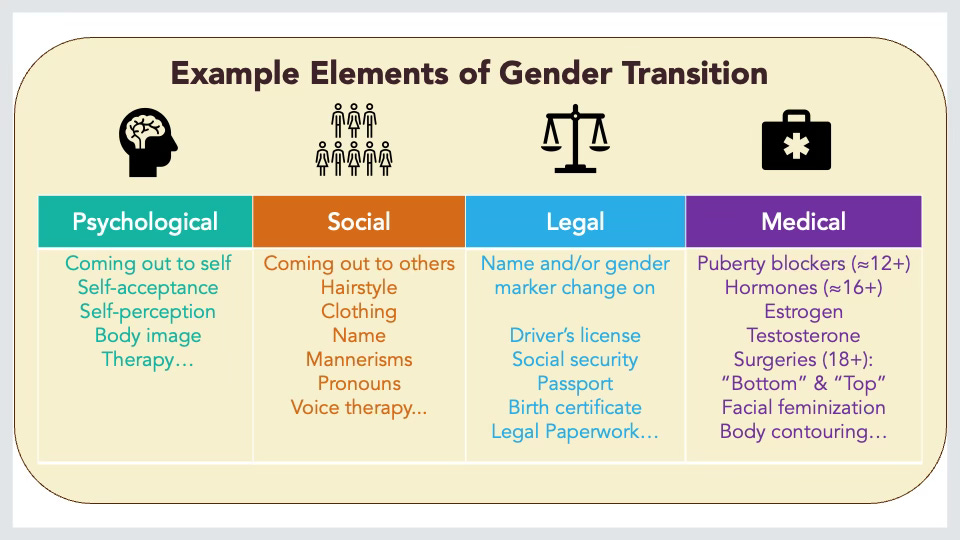Gender transition isn't what you think it is, Part 2: Social Transition
A series on psychological, social, legal, and medical transition & what it means to be trans
Read Part 1: Psychological Transition here.
As I said in Part 1, I find it helpful to break down gender transition into several major categories: psychological, social, legal, and medical. This gives us a framework to organize things around, but it isn’t The Truth or The Way. Let’s talk social transition.
Oh, look, I adapted an infographic from one of my lectures!

Social Transition
Social transition involves living as the affirmed gender in non-medical ways. This often includes change of name and pronouns, hairstyle, clothing and accessories, mannerisms, and style of speaking. When we talk about little trans kids, this is what we are talking about.
Before puberty, kids socially transition—that’s it. Nothing medical.
In a recent review of 5 million insurance claims across the US, zero kids under 12 had any medical procedure or prescription.
Socially transitioning is sharing or signaling your gender identity with others. This can be nonverbally (e.g., clothing) or verbally (e.g., coming out, changing pronouns). But this is a choose-your-own adventure kind of thing; people can do some and not others depending on what feels best to them.
When we socially transition, we are working with that concept of gender. Gender is many things: gender expression, gender roles and expectations, gender stereotypes, gender power inequities (and the health disparities that result), and more. These are all culturally determined and can vary across place and time—and they change and can be changed. What is considered masculine in one place may be considered feminine in another, and not associated with gender at all in yet another.
In US societies (and many others), we can signal our gender identity to others by changing our gender expression with hairstyles, makeup (or lack of makeup), accessories, and clothing. Note, however, that gender identity (something you feel inside) and gender expression (how you show your gender on the outside) are not the same thing, and don’t have to match. A person can dress in men’s clothes and be a man, a woman, or nonbinary.
That’s why it’s best to not assume. The most accurate way to learn someone's gender is to share or ask about gender identity explicitly (e.g., “What are your pronouns?” / “I use they/them”). (I edited out an aside about pronouns, grammar, and linguistics…saving for later.)
Western society also assigns gender to most names, so our names can be a way of indicating our gender (or not, with androgynous names). If names weren’t gendered, trans people would not feel the same need to change them.
Our society assigns gender to mannerisms like ways of walking, moving our hands, crossing our legs, etc. Nothing in our bodies or biological nature force men to cross their legs with one ankle on the other knee, or sit with their legs far apart. Women’s bodies don’t have to sit with legs together, or cross at the knees. It’s societal expectations and clothing styles (dresses vs pants) that led to that, and we as a society repeat and enforce those social norms. (“Sit like a lady!” “Don’t walk like that, people will think you’re gay!”) It’s really quite arbitrary.
I grew up as a girl and lived as a woman for decades before psychologically transitioning from the summer of 2016 to early 2018. During that time of exploration, I started socially transitioning by getting a queer haircut, wearing more androgynous clothes, and flattening my chest with a binder. I was living in a place where it was unsafe for me to come out, so for a year, the only people I came out to were my (ex)-husband, our son, and my best friend.
Once I moved to the US in the fall of 2018, I started living openly as a man. I had not started hormones, had any surgery, or changed any legal documents. I just introduced myself as Will, he/him, had a short haircut, wore clothes from the men’s section, bound my chest, and used the men’s or gender neutral restrooms. For my own comfort and safety, I used gender neutral locker rooms.
That’s it. That’s social transition.
For a variety of reasons, some people socially transition and don’t medically or legally transition. Those things may be unavailable or illegal where they live or unaffordable and not covered by insurance. Some people simply don’t want to.
They are still trans/nonbinary. They are enough.




I'm in the psychological -> social phase right now, and this series is coming at such a good time. Thank you for sharing your insights and helping me stay sane!! Your last bit about just living your life as you, pre anything medical or legal, going ahead with a new name and pronouns and style... it's inspiring.
Thanks for taking the time to go through this it is helpful